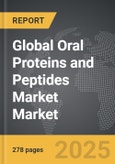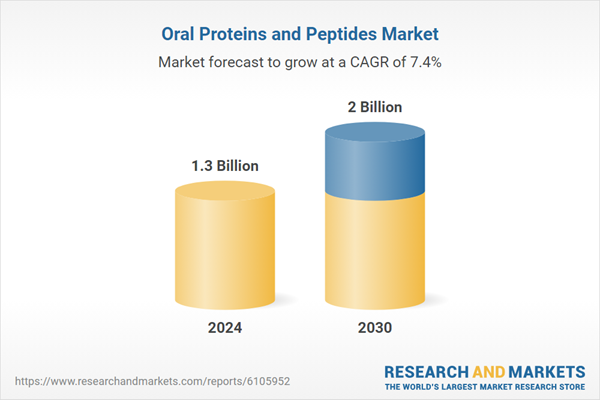Global Oral Proteins and Peptides Market - Key Trends & Drivers Summarized
Why Has Oral Delivery of Proteins and Peptides Remained Technically Difficult?
Proteins and peptides are sensitive biological molecules with poor intrinsic stability in the digestive system. When administered orally, they face rapid degradation by gastric enzymes and harsh pH conditions, followed by limited intestinal absorption due to large molecular size and hydrophilicity. These barriers have historically limited oral use of therapeutic proteins, pushing most into parenteral routes. However, recent scientific progress is making oral delivery more plausible, driving new investment in peptide-based oral drug development.The motivation behind oral delivery is strong, particularly for long-term treatments like diabetes, growth disorders, and hormonal deficiencies. Patients prefer oral therapies over injections for convenience, comfort, and reduced risk of injection-related complications. Hence, the pharmaceutical industry is actively working on approaches to stabilize peptide structures and promote mucosal transport for systemic absorption.
What Formulation Techniques Are Enabling Systemic Uptake via the GI Tract?
Several formulation strategies are under active development to enable oral delivery of peptides and proteins. Use of enteric-coated capsules and enzyme inhibitors helps protect the drug until it reaches the intestine. Absorption enhancers such as medium-chain fatty acids and bile salts are employed to loosen tight junctions in the intestinal lining, temporarily increasing permeability. Carrier systems like nanoparticles, self-emulsifying drug delivery systems (SEDDS), and lipid-based formulations are designed to improve drug solubility and stability.Technologies such as permeation-enhancing microcontainers, mucoadhesive films, and transcellular transporters are being refined to achieve consistent and safe absorption. Structural modification of peptides, including cyclization and D-amino acid substitution, improves resistance to enzymatic cleavage without affecting biological activity. These methods are allowing more peptide drugs to achieve bioavailability levels sufficient for therapeutic effect.
Which Therapies Are Leading in Development and Where Is Innovation Concentrated?
Diabetes and metabolic disorders are the leading therapeutic segments for oral peptide development. Oral semaglutide, a GLP-1 receptor agonist for type 2 diabetes, is the most notable commercial success, marking a breakthrough in this space. Similar efforts are targeting oral formulations of insulin, parathyroid hormone, and calcitonin for osteoporosis and thyroid-related disorders.Biopharmaceutical companies are also exploring oral delivery of peptide-based immunotherapies and anti-inflammatory agents for conditions such as rheumatoid arthritis and ulcerative colitis. North America and select European countries are leading innovation due to strong R&D infrastructure and regulatory engagement. Emerging economies are watching closely for cost-effective formulations to broaden access.
Growth in the Oral Proteins and Peptides market is driven by several factors…
Growth in the oral proteins and peptides market is driven by factors such as increasing demand for convenient alternatives to injectable biologics, progress in drug stabilization techniques, and growing therapeutic use of peptides in chronic diseases. Rising adoption of GLP-1 analogs and other metabolic treatments is fueling commercial interest in oral peptide delivery platforms.Advancements in bioavailability enhancers, protective coatings, and intestinal absorption models are supporting wider application of peptide therapies in outpatient settings. Expansion of clinical pipelines, coupled with favorable patient preferences and emerging regulatory approvals, is creating a strong foundation for long-term market growth. Strategic partnerships between biotech firms and delivery technology companies are further accelerating the pace of innovation in this evolving field.
Report Scope
The report analyzes the Oral Proteins and Peptides market, presented in terms of market value (US$). The analysis covers the key segments and geographic regions outlined below:- Segments: Drug Type (Calcitonin Drug Type, Insulin Drug Type, Linaclotide Drug Type, Octreotide Drug Type, Plecanatide Drug Type); Application (Bone Diseases Application, Diabetes Application, Gastric & Digestive Disorders Application, Hormonal Disorders Application).
- Geographic Regions/Countries: World; United States; Canada; Japan; China; Europe (France; Germany; Italy; United Kingdom; Spain; Russia; and Rest of Europe); Asia-Pacific (Australia; India; South Korea; and Rest of Asia-Pacific); Latin America (Argentina; Brazil; Mexico; and Rest of Latin America); Middle East (Iran; Israel; Saudi Arabia; United Arab Emirates; and Rest of Middle East); and Africa.
Key Insights:
- Market Growth: Understand the significant growth trajectory of the Calcitonin Drug segment, which is expected to reach US$762.5 Million by 2030 with a CAGR of a 6.1%. The Insulin Drug segment is also set to grow at 9.6% CAGR over the analysis period.
- Regional Analysis: Gain insights into the U.S. market, valued at $351.6 Million in 2024, and China, forecasted to grow at an impressive 11.3% CAGR to reach $411.9 Million by 2030. Discover growth trends in other key regions, including Japan, Canada, Germany, and the Asia-Pacific.
Why You Should Buy This Report:
- Detailed Market Analysis: Access a thorough analysis of the Global Oral Proteins and Peptides Market, covering all major geographic regions and market segments.
- Competitive Insights: Get an overview of the competitive landscape, including the market presence of major players across different geographies.
- Future Trends and Drivers: Understand the key trends and drivers shaping the future of the Global Oral Proteins and Peptides Market.
- Actionable Insights: Benefit from actionable insights that can help you identify new revenue opportunities and make strategic business decisions.
Key Questions Answered:
- How is the Global Oral Proteins and Peptides Market expected to evolve by 2030?
- What are the main drivers and restraints affecting the market?
- Which market segments will grow the most over the forecast period?
- How will market shares for different regions and segments change by 2030?
- Who are the leading players in the market, and what are their prospects?
Report Features:
- Comprehensive Market Data: Independent analysis of annual sales and market forecasts in US$ Million from 2024 to 2030.
- In-Depth Regional Analysis: Detailed insights into key markets, including the U.S., China, Japan, Canada, Europe, Asia-Pacific, Latin America, Middle East, and Africa.
- Company Profiles: Coverage of players such as Adare Pharma Solutions, Aquestive Therapeutics, Catalent Pharma Solutions, Croda International Plc, Entera Bio Ltd. and more.
- Complimentary Updates: Receive free report updates for one year to keep you informed of the latest market developments.
Some of the 32 companies featured in this Oral Proteins and Peptides market report include:
- AbbVie Inc.
- Abbott Laboratories
- Amgen Inc.
- AstraZeneca PLC
- Biocon Limited
- Boehringer Ingelheim
- Bristol-Myers Squibb Company
- Chiasma Inc.
- Entera Bio Ltd.
- F. Hoffmann-La Roche Ltd.
- Eli Lilly and Company
- Merck & Co., Inc.
- Nektar Therapeutics
- Novo Nordisk A/S
- Oramed Pharmaceuticals Inc.
- Pfizer Inc.
- Protagonist Therapeutics, Inc.
- Proxima Concepts Limited
- Rani Therapeutics, LLC
- Sanofi S.A.
- Synergy Pharmaceuticals Inc.
This edition integrates the latest global trade and economic shifts into comprehensive market analysis. Key updates include:
- Tariff and Trade Impact: Insights into global tariff negotiations across 180+ countries, with analysis of supply chain turbulence, sourcing disruptions, and geographic realignment. Special focus on 2025 as a pivotal year for trade tensions, including updated perspectives on the Trump-era tariffs.
- Adjusted Forecasts and Analytics: Revised global and regional market forecasts through 2030, incorporating tariff effects, economic uncertainty, and structural changes in globalization. Includes historical analysis from 2015 to 2023.
- Strategic Market Dynamics: Evaluation of revised market prospects, regional outlooks, and key economic indicators such as population and urbanization trends.
- Innovation & Technology Trends: Latest developments in product and process innovation, emerging technologies, and key industry drivers shaping the competitive landscape.
- Competitive Intelligence: Updated global market share estimates for 2025, competitive positioning of major players (Strong/Active/Niche/Trivial), and refined focus on leading global brands and core players.
- Expert Insight & Commentary: Strategic analysis from economists, trade experts, and domain specialists to contextualize market shifts and identify emerging opportunities.
Table of Contents
Companies Mentioned (Partial List)
A selection of companies mentioned in this report includes, but is not limited to:
- AbbVie Inc.
- Abbott Laboratories
- Amgen Inc.
- AstraZeneca PLC
- Biocon Limited
- Boehringer Ingelheim
- Bristol-Myers Squibb Company
- Chiasma Inc.
- Entera Bio Ltd.
- F. Hoffmann-La Roche Ltd.
- Eli Lilly and Company
- Merck & Co., Inc.
- Nektar Therapeutics
- Novo Nordisk A/S
- Oramed Pharmaceuticals Inc.
- Pfizer Inc.
- Protagonist Therapeutics, Inc.
- Proxima Concepts Limited
- Rani Therapeutics, LLC
- Sanofi S.A.
- Synergy Pharmaceuticals Inc.
Table Information
| Report Attribute | Details |
|---|---|
| No. of Pages | 278 |
| Published | December 2025 |
| Forecast Period | 2024 - 2030 |
| Estimated Market Value ( USD | $ 1.3 Billion |
| Forecasted Market Value ( USD | $ 2 Billion |
| Compound Annual Growth Rate | 7.4% |
| Regions Covered | Global |









